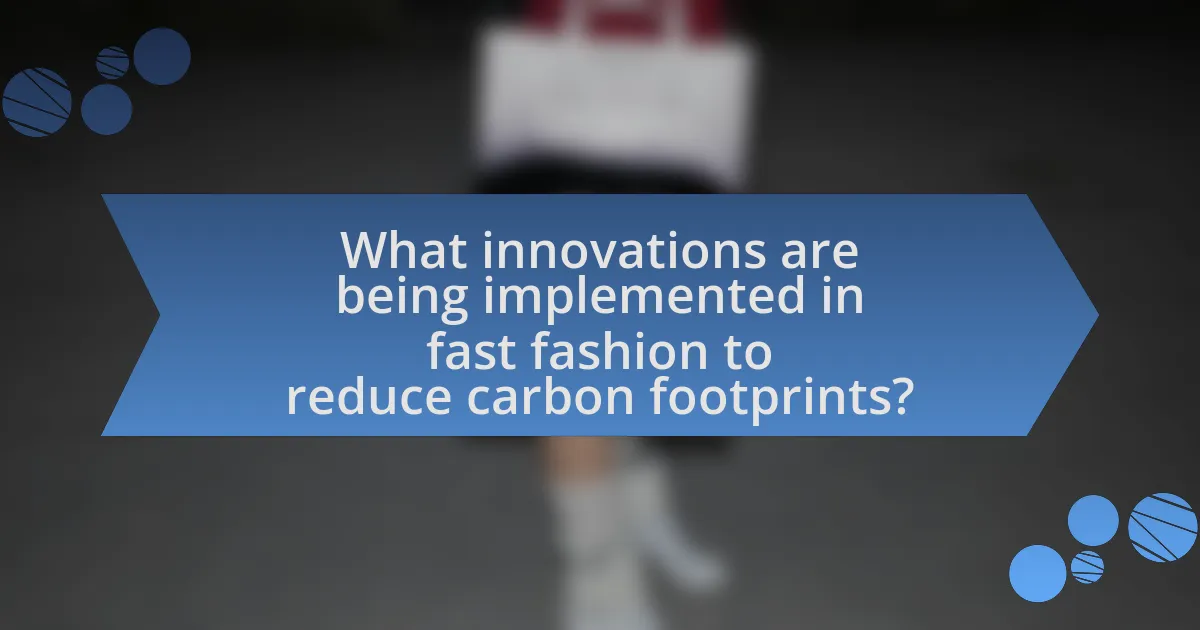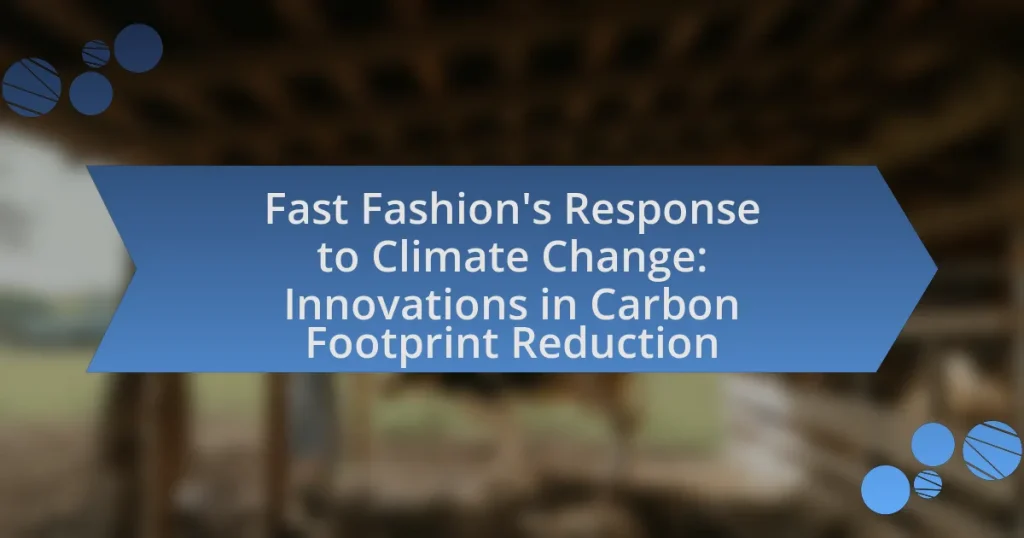Fast fashion brands are increasingly responding to climate change by adopting sustainable practices aimed at reducing their carbon footprints. This article examines the significant contributions of fast fashion to climate change, including high carbon emissions, water pollution, and waste generation. It highlights the urgent need for the industry to innovate through the use of eco-friendly materials, circular production processes, and advanced supply chain technologies. Additionally, the article discusses the challenges faced by fast fashion in implementing these sustainable practices, the role of consumer expectations, and the importance of collaboration within the industry to drive meaningful change.
What is Fast Fashion’s Response to Climate Change?
Fast fashion brands are increasingly adopting sustainable practices to mitigate their impact on climate change. These responses include implementing eco-friendly materials, optimizing supply chains for reduced emissions, and investing in renewable energy sources. For instance, brands like H&M and Zara have committed to using 100% sustainable cotton and linen by 2025, demonstrating a shift towards more responsible sourcing. Additionally, the Global Fashion Agenda’s 2021 report highlights that the fashion industry must reduce greenhouse gas emissions by 1.1 billion tons annually to align with climate goals, emphasizing the urgency for fast fashion to innovate and adapt.
How does fast fashion contribute to climate change?
Fast fashion contributes to climate change primarily through high carbon emissions associated with its production processes. The fast fashion industry is responsible for approximately 10% of global carbon emissions, largely due to the use of fossil fuels in manufacturing and transportation. Additionally, the rapid production cycles lead to increased waste, as unsold garments often end up in landfills, where they decompose and release methane, a potent greenhouse gas. The reliance on synthetic materials, which are derived from petroleum, further exacerbates the industry’s carbon footprint.
What are the primary environmental impacts of fast fashion?
The primary environmental impacts of fast fashion include significant water pollution, excessive water consumption, and substantial greenhouse gas emissions. Fast fashion production processes often involve the use of toxic chemicals, which contaminate water sources; for instance, the textile industry is responsible for 20% of global wastewater. Additionally, the industry consumes around 93 billion cubic meters of water annually, exacerbating water scarcity issues. Furthermore, fast fashion contributes to approximately 10% of global carbon emissions, with the production and transportation of garments being major contributors to this figure.
How does the production process in fast fashion affect carbon emissions?
The production process in fast fashion significantly increases carbon emissions due to its reliance on rapid manufacturing, synthetic materials, and global supply chains. Fast fashion brands often produce clothing in large quantities to meet consumer demand quickly, which leads to high energy consumption and greenhouse gas emissions during production. For instance, the fashion industry is responsible for approximately 10% of global carbon emissions, with fast fashion contributing a substantial portion due to its intensive use of fossil fuels in manufacturing and transportation. Additionally, the use of synthetic fibers, such as polyester, which are derived from petroleum, further exacerbates carbon output. The combination of these factors illustrates how the fast fashion production process directly impacts carbon emissions, highlighting the urgent need for sustainable practices in the industry.
Why is carbon footprint reduction important for the fast fashion industry?
Carbon footprint reduction is crucial for the fast fashion industry because it directly addresses the significant environmental impact associated with clothing production and consumption. The fast fashion sector is responsible for approximately 10% of global carbon emissions, primarily due to energy-intensive manufacturing processes and transportation. By reducing carbon footprints, companies can mitigate climate change effects, enhance sustainability, and meet increasing consumer demand for environmentally responsible practices. Furthermore, regulatory pressures and potential financial penalties for high emissions make carbon reduction not only an ethical imperative but also a strategic business necessity.
What are the consequences of ignoring carbon footprint reduction?
Ignoring carbon footprint reduction leads to severe environmental consequences, including accelerated climate change, increased global temperatures, and heightened frequency of extreme weather events. The Intergovernmental Panel on Climate Change (IPCC) reports that failing to limit greenhouse gas emissions could result in a temperature rise of 1.5 degrees Celsius above pre-industrial levels by 2030, causing significant disruptions to ecosystems and human societies. Additionally, the World Health Organization (WHO) indicates that climate change exacerbates health risks, leading to increased respiratory diseases and heat-related illnesses. Therefore, neglecting carbon footprint reduction not only threatens biodiversity but also poses substantial risks to public health and economic stability.
How can reducing carbon footprints benefit fast fashion brands?
Reducing carbon footprints can benefit fast fashion brands by enhancing their brand image and attracting environmentally conscious consumers. As sustainability becomes a priority for consumers, brands that actively reduce their carbon emissions can differentiate themselves in a competitive market. For instance, a study by McKinsey & Company found that 67% of consumers consider sustainability when making a purchase, indicating a strong market demand for eco-friendly practices. Additionally, implementing carbon reduction strategies can lead to cost savings through improved efficiency and waste reduction, further strengthening a brand’s financial performance.

What innovations are being implemented in fast fashion to reduce carbon footprints?
Fast fashion brands are implementing innovations such as sustainable materials, circular production processes, and advanced supply chain technologies to reduce carbon footprints. For instance, companies are increasingly using recycled fabrics and organic cotton, which significantly lower greenhouse gas emissions compared to conventional materials. Additionally, the adoption of circular economy principles, where garments are designed for reuse and recycling, minimizes waste and resource consumption. Technologies like AI and blockchain are also being utilized to optimize supply chains, reducing energy use and emissions during production and distribution. These strategies collectively contribute to a more sustainable fast fashion industry, addressing its significant environmental impact.
How are materials and sourcing changing in fast fashion?
Materials and sourcing in fast fashion are increasingly shifting towards sustainable and eco-friendly options. Brands are adopting organic cotton, recycled polyester, and innovative materials like Tencel and hemp to reduce environmental impact. For instance, a report by McKinsey & Company highlights that 60% of fashion brands are now prioritizing sustainable materials in their sourcing strategies. This change is driven by consumer demand for transparency and sustainability, as well as regulatory pressures aimed at reducing carbon footprints in the industry.
What sustainable materials are being adopted by fast fashion brands?
Fast fashion brands are increasingly adopting sustainable materials such as organic cotton, recycled polyester, Tencel, and hemp. Organic cotton is grown without synthetic pesticides and fertilizers, reducing environmental impact. Recycled polyester, made from post-consumer plastic bottles, diverts waste from landfills and decreases reliance on virgin materials. Tencel, derived from sustainably sourced wood pulp, is produced in a closed-loop process that minimizes water and chemical use. Hemp is a fast-growing crop that requires fewer resources and can improve soil health. These materials reflect a shift towards more environmentally responsible practices in the fast fashion industry.
How does ethical sourcing impact carbon emissions?
Ethical sourcing significantly reduces carbon emissions by prioritizing sustainable practices throughout the supply chain. This approach often involves selecting materials that are produced with lower environmental impact, such as organic cotton or recycled fibers, which require less energy and water compared to conventional materials. For instance, a study by the Textile Exchange found that organic cotton farming can reduce greenhouse gas emissions by up to 46% compared to conventional cotton farming. Additionally, ethical sourcing encourages local production, which minimizes transportation emissions associated with long-distance shipping. By implementing these practices, brands can effectively lower their overall carbon footprint, contributing to climate change mitigation efforts.
What technological advancements are aiding carbon footprint reduction?
Technological advancements aiding carbon footprint reduction include renewable energy technologies, energy-efficient manufacturing processes, and sustainable materials development. Renewable energy technologies, such as solar and wind power, significantly decrease reliance on fossil fuels, which are major contributors to carbon emissions. For instance, the International Renewable Energy Agency reported that renewable energy sources accounted for 29% of global electricity generation in 2020, illustrating their growing impact. Energy-efficient manufacturing processes, including automation and smart technologies, optimize resource use and minimize waste, further reducing emissions. Additionally, the development of sustainable materials, such as bio-based fabrics and recycled textiles, helps lower the carbon footprint associated with production. According to a study published in the Journal of Cleaner Production, using recycled materials can reduce greenhouse gas emissions by up to 70% compared to virgin materials. These advancements collectively contribute to significant reductions in carbon footprints across various industries, including fast fashion.
How is technology transforming production processes in fast fashion?
Technology is transforming production processes in fast fashion by enabling rapid design, efficient manufacturing, and sustainable practices. Advanced software tools, such as 3D design and virtual prototyping, allow brands to create and modify designs quickly, reducing lead times significantly. Automation in manufacturing, including robotics and AI-driven systems, enhances efficiency and minimizes waste, aligning with sustainability goals. For instance, companies like Zara utilize data analytics to forecast trends and optimize inventory, which reduces overproduction and excess stock. Additionally, innovations in materials, such as recycled fabrics and eco-friendly dyes, contribute to lowering the carbon footprint of production processes. These technological advancements collectively support fast fashion’s adaptation to climate change by promoting efficiency and sustainability.
What role does data analytics play in optimizing supply chains?
Data analytics plays a crucial role in optimizing supply chains by enabling organizations to make data-driven decisions that enhance efficiency and reduce costs. By analyzing historical data, companies can identify patterns and trends in demand, inventory levels, and supplier performance, which allows for better forecasting and inventory management. For instance, a study by McKinsey & Company found that companies using advanced analytics in their supply chains can reduce logistics costs by 15% and inventory costs by 30%. This optimization not only improves operational efficiency but also contributes to sustainability efforts by minimizing waste and carbon emissions associated with overproduction and excess inventory.

What are the challenges faced by fast fashion in implementing these innovations?
Fast fashion faces significant challenges in implementing innovations aimed at reducing carbon footprints, primarily due to cost constraints, supply chain complexities, and consumer demand for rapid production. The financial burden of adopting sustainable materials and technologies often exceeds the budgets of fast fashion brands, which prioritize low-cost production. Additionally, the intricate global supply chains make it difficult to integrate new sustainable practices consistently across all levels of production. Consumer expectations for quick turnaround times further complicate the adoption of slower, more sustainable manufacturing processes, creating a conflict between sustainability goals and market demands. These factors collectively hinder the effective implementation of carbon footprint reduction innovations in the fast fashion industry.
What barriers exist for fast fashion brands in adopting sustainable practices?
Fast fashion brands face significant barriers in adopting sustainable practices, primarily due to cost constraints, consumer demand for low prices, and supply chain complexities. The financial implications of transitioning to sustainable materials and processes often deter brands from making changes, as these practices can increase production costs. Additionally, consumer behavior heavily favors affordability and rapid turnover of styles, which conflicts with the principles of sustainability that emphasize quality and longevity. Furthermore, the intricate global supply chains that fast fashion relies on complicate the implementation of sustainable practices, as many suppliers may not adhere to environmental standards. These factors collectively hinder the ability of fast fashion brands to effectively integrate sustainability into their operations.
How do consumer expectations influence fast fashion’s sustainability efforts?
Consumer expectations significantly influence fast fashion’s sustainability efforts by driving brands to adopt more eco-friendly practices. As consumers increasingly prioritize sustainability, fast fashion companies respond by implementing initiatives such as using recycled materials, reducing waste, and improving supply chain transparency. For instance, a 2021 survey by McKinsey & Company found that 67% of consumers consider sustainability when making a purchase, prompting brands like H&M and Zara to launch sustainable collections and set ambitious carbon reduction targets. This shift in consumer behavior compels fast fashion retailers to innovate and align their business models with environmental concerns, ultimately impacting their operational strategies and product offerings.
What financial challenges do brands face when transitioning to sustainable practices?
Brands face significant financial challenges when transitioning to sustainable practices, primarily due to the high initial investment costs associated with sustainable materials and technologies. For instance, adopting eco-friendly materials often requires brands to invest in new supply chains and production processes, which can be substantially more expensive than traditional methods. According to a report by McKinsey & Company, the cost of sustainable materials can be up to 30% higher than conventional options, impacting profit margins. Additionally, brands may encounter increased operational costs related to compliance with environmental regulations and certifications, which can further strain financial resources. These challenges are compounded by the potential for reduced consumer demand during the transition period, as customers may be hesitant to pay higher prices for sustainable products.
How can fast fashion brands overcome these challenges?
Fast fashion brands can overcome challenges related to climate change by adopting sustainable practices such as using eco-friendly materials, implementing circular economy principles, and enhancing supply chain transparency. For instance, brands like H&M and Zara have begun incorporating organic cotton and recycled polyester into their collections, which significantly reduces their carbon footprint. Additionally, the adoption of circular economy strategies, such as take-back programs and recycling initiatives, helps minimize waste and promotes resource efficiency. Research from the Ellen MacArthur Foundation indicates that transitioning to a circular economy could reduce global textile waste by 22 million tons annually, demonstrating the potential impact of these strategies on sustainability in the fast fashion industry.
What strategies can be employed to educate consumers about sustainability?
To educate consumers about sustainability, brands can implement strategies such as transparent communication, educational campaigns, and partnerships with environmental organizations. Transparent communication involves sharing information about sourcing, production processes, and environmental impacts, which helps consumers make informed choices. Educational campaigns can include workshops, social media content, and informative packaging that highlight sustainable practices and their benefits. Collaborating with environmental organizations can enhance credibility and provide consumers with access to expert knowledge and resources, fostering a deeper understanding of sustainability issues. These strategies are supported by research indicating that informed consumers are more likely to engage in sustainable purchasing behaviors, as evidenced by a study published in the Journal of Consumer Research, which found that transparency significantly influences consumer trust and purchasing decisions.
How can collaboration within the industry facilitate change?
Collaboration within the fast fashion industry can facilitate change by enabling shared resources, knowledge, and best practices that drive sustainable innovations. For instance, partnerships between brands, suppliers, and environmental organizations can lead to the development of eco-friendly materials and production techniques, significantly reducing carbon footprints. A notable example is the Fashion Pact, which unites over 60 companies committed to environmental goals, demonstrating that collective action can amplify impact. This collaborative approach not only accelerates the adoption of sustainable practices but also fosters accountability and transparency across the supply chain, ultimately leading to meaningful change in addressing climate challenges.
What practical steps can consumers take to support sustainable fast fashion?
Consumers can support sustainable fast fashion by choosing brands that prioritize ethical production practices and environmentally friendly materials. By researching and selecting companies that utilize organic fabrics, recycled materials, and transparent supply chains, consumers can directly influence the market demand for sustainable practices. For instance, brands like Reformation and Patagonia are known for their commitment to sustainability, which is evidenced by their use of eco-friendly materials and fair labor practices. Additionally, consumers can reduce their overall consumption by buying second-hand clothing, which extends the lifecycle of garments and minimizes waste. According to a report by the Ellen MacArthur Foundation, extending the life of clothing by just nine months can reduce carbon, water, and waste footprints by around 20-30%. By making informed purchasing decisions and advocating for sustainable practices, consumers play a crucial role in driving the fast fashion industry towards more sustainable innovations.
How can consumers make informed choices when shopping for fast fashion?
Consumers can make informed choices when shopping for fast fashion by researching brands’ sustainability practices and understanding the environmental impact of their purchases. Many fast fashion brands have begun to disclose information about their carbon footprints and supply chain practices, allowing consumers to compare their commitments to sustainability. For instance, a 2021 report by the Fashion Transparency Index revealed that only 40% of brands disclose their environmental policies, highlighting the importance of seeking out transparent companies. Additionally, consumers can look for certifications such as Global Organic Textile Standard (GOTS) or Fair Trade, which indicate adherence to specific environmental and ethical standards. By prioritizing brands that demonstrate accountability and sustainability, consumers can contribute to reducing the negative impact of fast fashion on climate change.
What role does second-hand shopping play in reducing carbon footprints?
Second-hand shopping significantly reduces carbon footprints by extending the lifecycle of clothing and minimizing the demand for new production. When consumers purchase used items, they decrease the need for manufacturing, which is responsible for substantial greenhouse gas emissions; for instance, the production of a single cotton t-shirt can emit approximately 2.1 kg of CO2. Additionally, second-hand shopping diverts textiles from landfills, where they contribute to methane emissions as they decompose. According to a study by the Ellen MacArthur Foundation, increasing the reuse of clothing could reduce global carbon emissions by 44 million tons by 2030. Thus, second-hand shopping plays a crucial role in mitigating climate change impacts associated with the fashion industry.














